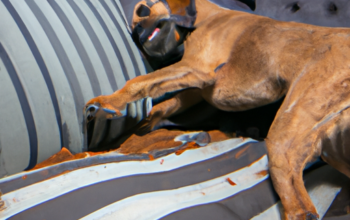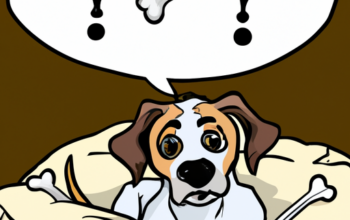Just as the Trojan horse unleashed havoc, hidden and unexpected, on the city of Troy, so does canine distemper virus (CDV) upon our beloved canines.
CDV is a highly contagious and lethal disease that targets dogs but can also affect other animals. Imagine opening your home to a seemingly harmless pup only to find it carrying an invader that could endanger your entire pet family.
You’re probably wondering what exactly distemper in dogs is? It’s a serious viral illness with no known cure, caused by the canine distemper virus. The virus attacks the respiratory, gastrointestinal, and nervous systems of puppies and dogs alike.
Recognizing the symptoms early on can make all the difference in managing this devastating disease. Knowing how it spreads will arm you against potential threats, while understanding prevention methods like vaccination can be your best line of defense.
As we dive into treatment options and recovery possibilities later in this article, you’ll gain insights into battling this invisible enemy efficiently.
Understanding the Nature of the Disease
You might be wondering what distemper is – it’s a highly contagious and potentially deadly virus that affects a dog’s respiratory, gastrointestinal, and nervous systems. The disease origin can be traced back to the genus Morbillivirus of the family Paramyxoviridae. This virus is closely related to the human measles virus with similar characteristics in terms of its detrimental effects on health.
It primarily targets dogs but can also affect other animals like raccoons, wolves, foxes, and skunks. It spreads through airborne exposure or contact with an infected animal’s bodily fluids like urine, feces, or saliva.
In your quest to understand this lethal disease more comprehensively, you might come across the term Genetic Predisposition. Essentially, it means that some dogs are naturally more susceptible to the disease than others due to their genetic makeup. Certain breeds such as Siberian Huskies and Alaskan Malamutes have shown an increased susceptibility to canine distemper. However, it’s important not to panic as being genetically predisposed doesn’t mean your pet will definitely contract distemper; there are several preventive measures available which we’ll discuss shortly.
Clearly understanding the nature of this disease helps in strategizing effective prevention and treatment methods for our furry friends’ well-being.
Symptoms to Watch Out For
Like a thief in the night, this disease can sneak up on your beloved pet, revealing itself through signs such as high fever, watery discharge from the eyes and nose, lethargy, coughing, vomiting, and diarrhea. Distemper in dogs can be particularly distressing because it’s not just a physical ailment; it also brings about behavioral changes that might seem out of character for your dog. You may notice an increased anxiety level or abnormal aggression. Other times you may observe compulsive behaviors such as excessive licking or biting themselves.
Moreover, appetite fluctuations are another key symptom to look out for. You might find:
-
Your usually enthusiastic eater suddenly loses interest in their food.
-
They start eating more than usual but still seem to lose weight.
-
Their water consumption changes dramatically.
-
There are visible changes in their stool consistency or color.
These symptoms should ring alarm bells and prompt an immediate visit to the vet’s office as they could indicate that distemper has taken hold of your dog’s health system. Remember that early detection is critical when dealing with a potentially fatal disease like distemper – so don’t brush off these signs as mere inconveniences or quirks; they could mean life or death for your precious pet!
How the Disease Spreads
Unbeknownst to many pet owners, this perilous ailment can rapidly spread from one furry friend to another in a variety of unsuspecting ways. Distemper in dogs is primarily transmitted via respiratory droplets from an infected dog or wild animals such as foxes and raccoons, which are known carrier animals. When your pet inhales these contaminated droplets, they can contract the disease swiftly. Moreover, shared food bowls and water dishes serve as perfect conduits for the disease’s transmission.
Direct contact with urine, blood or saliva of an infected animal also poses a high risk of transmitting distemper among dogs. It’s crucial to remember that newly born puppies can contract the disease directly from their mother during or shortly after birth if she is infected. Here’s a simple table summarizing common transmission methods:
| Transmission Method | Risk Level | Preventive Measures |
|---|---|---|
| Respiratory Droplets | High | Vaccination & Isolation of Infected Pets |
| Shared Food Bowls/Water Dishes | High | Regular Cleaning & No Sharing |
| Direct Contact with Urine/Blood/Saliva | Very High | Avoidance of Infected Animals |
| Mother to Puppies at Birth | Very High | Ensuring Mother is Disease-free |
Stay vigilant and monitor any changes in your pet’s behavior or health status. Preventing distemper involves maintaining good hygiene practices and keeping your pets up-to-date on vaccinations.
Prevention and Vaccination
Ensuring your furry friend’s health and safety starts with prevention, and there’s no better way than getting them vaccinated on time.
The importance of vaccine schedules can’t be overstated when it comes to protecting your pet from distemper. This viral disease is preventable through a series of vaccinations that are typically started when puppies are six to eight weeks of age, followed by booster shots throughout their lives. Adherence to these vaccine schedules provides an immunity boost against the virus, thereby reducing the chances of infection.
Remember, just as in human healthcare, preventive measures in animal health are far more effective than trying to cure a disease once it has taken hold.
Regular vet visits ensure not only timely vaccinations but also surveillance for any signs of illness or distress in your dog. Immunity boosting isn’t achieved overnight; it requires consistency and commitment from you as a pet owner.
So, take the time now to speak with your veterinarian about the best vaccination schedule for your canine companion – this simple step could save their life down the line.
Treatment Options and Recovery
Should your fur baby unfortunately fall ill, it’s crucial to know that there are treatment options available to help them recover and get back on their paws. Canine distemper is a serious viral illness, but with early detection and proper medical intervention, your pet has a fighting chance.
The primary goal of treatment is supportive care to help the dog’s system combat the virus effectively. This often involves hospitalization where your pet will receive intravenous fluids for dehydration, antibiotics for secondary bacterial infections, and medications to control vomiting or seizures if present.
While veterinary support is essential in treating distemper, there are also home remedies that can complement the professional care provided by your vet. These include:
- Proper Nutrition: A high-quality diet rich in vitamins and minerals boosts immunity.
- Hydration: Ensure plenty of water intake to prevent dehydration caused by fever and excessive mucus production.
- Rest: Provide a quiet and comfortable space for your dog to rest; this aids recovery as energy is focused on healing.
- Regular Monitoring: Keep an eye on any changes in symptoms or behavior and communicate these promptly to your vet.
Post recovery care plays an equally important role in ensuring full recuperation from canine distemper. It involves regular check-ups with the veterinarian even after symptoms have subsided, continued balanced nutrition, gradual reintroduction of physical activities, and maintaining up-to-date vaccinations going forward.
Remember, while this journey may seem daunting at first glance – it’s all about doing everything possible for the health of our beloved four-legged friends!
Frequently Asked Questions
What breeds of dogs are most susceptible to distemper?
No specific breed is more susceptible to distemper. It’s crucial for all dogs, regardless of breed, to follow distemper prevention strategies and receive breed-specific vaccinations to safeguard their health.
How long does it take for symptoms to appear after exposure to the virus?
After exposure to the virus, the incubation period can range from three to six weeks. It’s during this time you’ll likely notice symptom recognition as your dog may begin exhibiting signs of illness.
Can distemper affect other pets or animals besides dogs?
Yes, distemper can affect other animals as well. It’s a cross species transmission disease that can impact ferrets and raccoons. This highlights the importance of distemper vaccination to protect your pets’ health.
What is the cost of treating a dog with distemper?
The cost for treating distemper in dogs varies widely, often reaching into thousands. However, Financial Assistance Options exist. Consider Distemper Prevention Costs as well; vaccinations are significantly cheaper than treatment, promoting better animal health.
Can a dog get distemper more than once in their lifetime?
Yes, a dog can contract distemper more than once if their immunity strength is weak. However, regular distemper vaccinations can significantly boost your pet’s immunity, effectively preventing repeated infections.
Conclusion
Now, it’s up to you. You’ve learned about the menacing distemper disease in dogs, its alarming symptoms, and how rapidly it can spread.
Will you be quick enough to spot the signs?
Remember, prevention is your best bet. Vaccinate your dog on time and keep them away from infected animals.
If distemper strikes despite your precautions, prompt medical intervention could save your pet’s life.
It’s a battle against time, but with knowledge as your weapon, victory can be yours.



